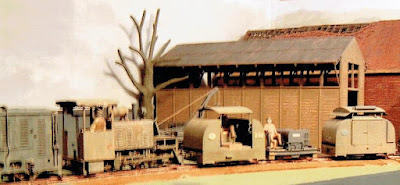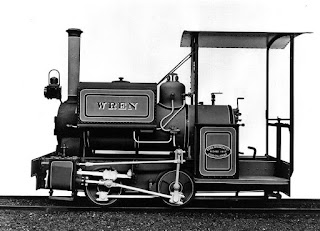Hello everyone. We hope that you are all staying happy and healthy after eleven months of lockdown.
Wrightscale Baldwin Gas Mechanical in weathered French Horizon Blue
In the last blog, topic paint, we were wondering if beauty was really just skin deep. As far as our models are concerned, if paint is beautiful, it is only good to behold if it is also functional. Let’s look over Malcolm’s shoulder as he prepares to paint a Wrightscale model.
The beauty depends on good preparation. Firstly there is research. The model has to be faithful to the original, with a livery that reflects the materials which the original engineers had to hand. Preparation continues with the choice of suitable modern materials. When painting the 19th and early 20th century prototypes, the pigment, binder and solvent of the paint available came from a limited range. The range of ingredients is wider now, but planning is still required, followed by skill, training and an artistic sense.
Finally, the physical preparations can begin.
Then, as now, the locomotive had to be clean. The prototype locomotive was as clean a practicable, given the vast area, time constraints and a dusty atmosphere. In spite of their best efforts, tiny specks were caught by the paint. David Sharp uses ultra-modern IT to scan the surfaces of surviving prototype locomotives; the scanners are so good that they pick up all the ancient grime painted into the surface. David has to go through the files and give the virtual locomotive a virtual ‘clean-up.’
Pictured above is a partly restored Baldwin Gas Mechanical at the Apedale Preserved Railway, photographed by Jim HawkesworthA Wrightscale model is physically cleaned to remove visible material. The next stage is putting it through an ultra-sound cleaner which removes the most persistent or tiniest blemishes. After thorough drying, it is carefully dusted.
Paint brands which Malcolm has used successfully are Halfords Car Spray, Tamiya Modelling paints and also Warhammer model paints.
Then, as now, the first coat of is a primer which sticks fast to the surface of the locomotive or rolling stock. Then, as now, the primer has to ‘key.’ These days you might say it has to ‘bite’, a term which is more than metaphorical. Primers were often corrosive when applied. Why dry, they had bonded to the metal.
The primers Malcolm uses still come with warnings. Etch primer – the term comes from the German ‘to eat’ - has to be treated with particular respect. For some applications, however, it has to be used.
For many purposes, Halfords primer is good, but the container must, all the same, be treated with care. It would be helpful if they listed all the ingredients, but we can take an educated guess, having read the warnings on the side of the can. The can is potentially explosive and from that we can deduce that the solvent is a volatile organic compound.
A Wrightscale 16mm Baldwin Gas Mechanical in grey primerAnother of the warnings concerns temperature. The action of painting slightly heats the surface of the metal. This suggests that the pigment/filler consist of the components and catalyst which form acrylic plastic. This is held in solution until sprayed and then there is a chemical reaction. At the end of the curing process, the paint layer is bound into the surface. Any harmful chemicals have been dispersed.
Paint spray has a short shelf life. This also suggests that the contents can form acrylic.. Leave a spray can too long and the components cure inside the tin.
The paint can only form a bond with the locomotive surface if conditions are right. The surfaces must be clean, dry and dust-free, as we have seen. Temperature and humidity must be correct, and spraying must not happen in direct sunlight. We can see why Malcolm’s long apprenticeship as a chemistry teacher proved useful.
When satisfactorily primed, Malcolm can move on to the next coat, and the next, and the next, up to half a dozen times. Working at 1:19 scale, Malcolm can’t use prototypical painting techniques – no ladling it on with a brush. The odd fly or dust grain didn’t matter at 1:1 scale, but with a model, every coat must be thin, even and consistent, using paint sprays. Between coats, the equipment must be thoroughly cleaned. Any lumps of old paint which make their way on to the next job will be horribly visible.
The 16mm Baldwin Gas Mechanical viewed from the back. This shade of grey shows every detail and every mistake in merciless clarity. It is just as well that Malcolm doesn't make many mistakes!Here is his advice to a friend about painting:
Within reason, it does not matter how long a model is left between coats assuming all is kept clean and dry. Do a test spray before starting, perhaps on an empty spray can, to check that the paint has not begun to cure. This also gives you a feel for how the paint sprays and what it looks like wet, part dry and fully dry. Each coat should be even and very light
If it’s a small item such as a wagon, I usually complete one side before starting the other. Spray the end and one side and the inside which can be reached. Then the model can be rotated, repeat for other side and end, then leave to start to dry (15min). Then, upside down, repeat the above. As you are doing this, make 2-3 light passes of spray over the sole bars, steps and under-frame. Rotate the wheels each pass to prime the face and rear of the wheels on the opposite side. Then spray the underside of the other side and end as before. Try to end up with two good passes on the sides/ends and a little heavier on the under-frame and wheels. The flanges clean easily at the end.
A Wrightscale model is finished with a protective layer of varnish. Vehicle paint on top of the recommended primer, followed by the recommended varnish seems like a good job well done. It will perform well under normal conditions, that is, as long as the painted surface stays within the recommended temperature range.
Wrightscale Baldwin Gas Mechanical, and friends, in khaki liveryThere is a ‘but’. For a 16mm scale locomotive, we have to admit that there is a slight gap between recommended and realistic temperature. Water levels vary between the beginning and the end of the run. That is what steam running is all about. If the boiler is nearly empty – which is in the nature of steam – the outside surfaces can get hot and the paintwork soft. It does make the locomotive hard to handle and marks the paint. This is a problem, we admit, and Malcolm is working on it.
There is also artistry, a topic we visit and revisit. A large surface, whether gloss or matt, gains a certain liveliness from reflections. Malcolm loves to convey this on a model. It’s the challenge, you see! He has a certain respect for Warhammer, the suppliers for a certain class of model warfare enthusiasts. They appreciate that what seems like the same shade of grey may have to include different qualities. Skull Grey or Wraith Grey may look the same to the uninitiated but in fact working out the base for these paints is a process of iteration and development. This sounds like marketing-speak, but Malcolm has found that the company knows its stuff. Using more than one shade from the range gives the surfaces of his locomotives new depths.
We come to the future. Even a studio as backward-looking as Wrightscale, creator of working models of 19th and 20th century prototypes, has to look forward. Malcolm uses non-ferrous metals, caustic substances and organic sprays with a heavy heart. At the moment they are necessary. Here comes the essential paradox of hazardous materials. The people who use them are the ones most eager to find replacements and the ones who probably will. We just cannot stress this enough.
Wrightscale Baldwin Gas Mechanical in fresh paintThe future offers tantalising possibilities, many from the natural world. The science of bio-mimetics, the looking for inspiration from the natural world, could be a great help. For example, a bio-glue copying some aspects of a slug’s secretions or a gecko’s toe, could play its part in paint primer. A bio-plastic made by an Australian bee could play its part in replacing acrylic in paint.
Or we could take a lesson from the tree. Like all living things, it needs trace elements. The soil provides these but as well as potassium, zinc and phosphorus which are essential to life, it has ‘nasties’ such as lead, cadmium and the so-called heavy metals, harmful to life. The roots of healthy trees have hidden helpers. Most root hairs are accompanied by fungal mycelia. These stretch further and seek more widely and have a fungussy intelligence. They take up the trace elements and tuck away the poisons. There is talk of using them to counter pollution.
The history of the Baldwin Gas Mechanical is described in Colonel Péchot: Tracks To The Trenches
‘The Hidden Life of Trees’ Peter Wohlleben describes some of the works of the fungus family









